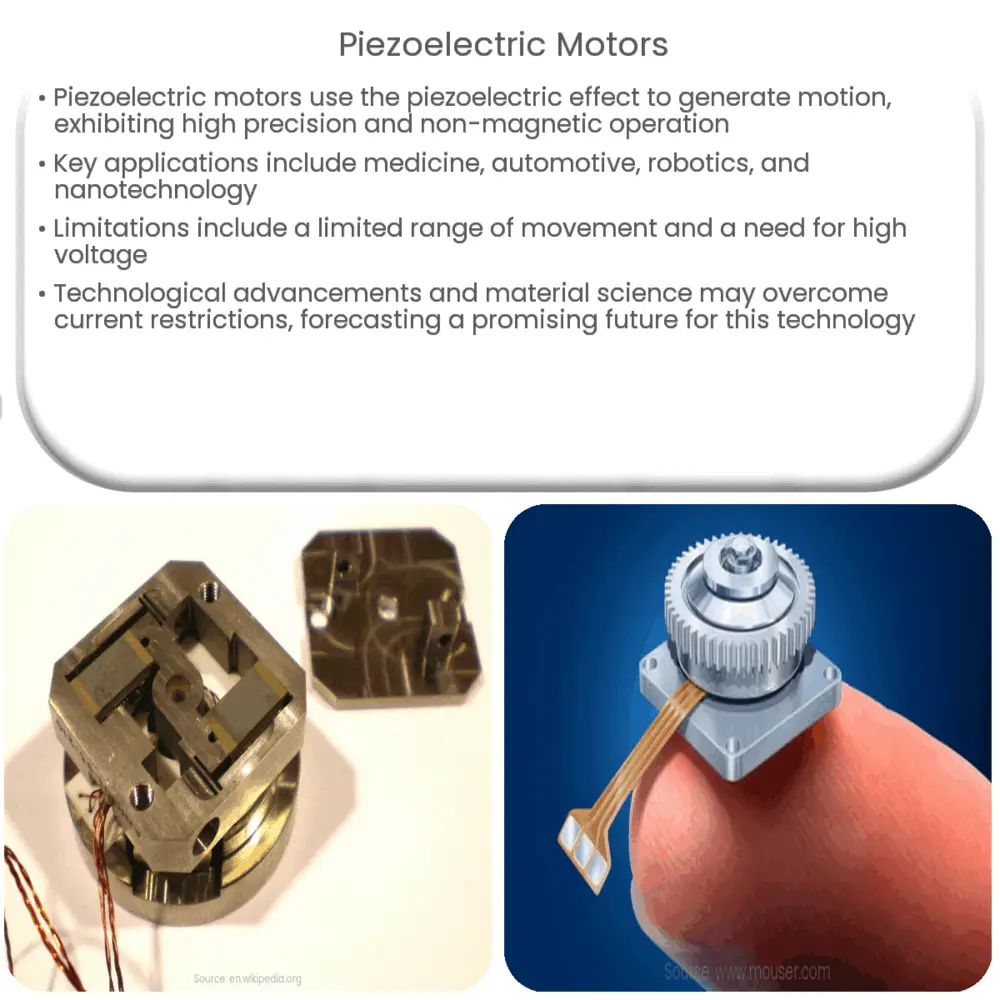Explore the workings, advantages, limitations, and applications of piezoelectric motors, and their promising future in tech advancements.

Piezoelectric Motors: A Comprehensive Guide
Piezoelectric motors, also known as piezo motors, are a type of electric motor based on the piezoelectric effect. This scientific phenomenon is where certain materials generate an electric charge in response to applied mechanical stress. These motors have various applications, from precision movement in microscopic instruments to larger, industrial machinery.
Understanding the Piezoelectric Effect
The piezoelectric effect is the key to the functioning of these motors. It is a fascinating scientific principle, discovered in the 19th century by the Curie brothers. Certain materials, including quartz and certain ceramics, generate an electric charge when pressure is applied. Conversely, these materials can also deform in response to an electric field, a characteristic utilized in piezoelectric motors.
Construction and Working Principle
The construction of piezoelectric motors is relatively simple. The main component is the piezoelectric element, often a ceramic, that expands or contracts based on the voltage applied to it. This piezoelectric element is connected to a mechanical part, such as a rotor in a rotary motor, or a slider in a linear motor.
- Linear piezoelectric motors: They use the linear movement of the piezoelectric element to generate motion. The expansion and contraction of the piezo element are translated into a linear movement via a coupling mechanism.
- Rotary piezoelectric motors: They exploit the deformation of the piezoelectric element to produce rotation. This is achieved through a specialized design where the piezoelectric elements are arranged in a circle, and their sequential activation creates a rotational motion.
Advantages of Piezoelectric Motors
Piezoelectric motors offer several unique advantages over traditional electromagnetic motors. These benefits stem from the intrinsic characteristics of the piezoelectric effect. Firstly, these motors are highly precise, with the ability to control movement down to the nanometer level. This makes them ideal for applications that require very fine positioning, such as in optics or nanotechnology.
Limitations and Challenges
While piezoelectric motors offer numerous benefits, they also have limitations. The most prominent of these are the limited range of movement and the requirement for high voltage to produce significant force. Furthermore, these motors often require complex drive circuits to manage the piezoelectric effect effectively.
Applications of Piezoelectric Motors
Thanks to their high precision and the ability to operate without magnetic fields, piezoelectric motors find applications in a variety of fields.
- Medical field: The precision of piezoelectric motors is highly valued in medical devices. They’re used in drug delivery systems, medical imaging devices like ultrasound probes, and precision surgical instruments.
- Automotive industry: Piezoelectric motors are used in car technology for controlling mirror positioning and fuel injection systems.
- Robotics and automation: The precision and small size of these motors make them suitable for robotics, particularly where precise movements are required.
- Optics and nanotechnology: In fields where the manipulation and positioning of components need to be at the nanometer level, piezoelectric motors come into play. They are essential in the alignment and operation of microscopes, telescopes, and other optical devices.
Future of Piezoelectric Motors
The future of piezoelectric motors seems promising. As our technology and understanding of the piezoelectric effect improve, we can expect to overcome some of the current limitations of these motors. Developments in material science are leading to piezoelectric materials with enhanced properties, potentially leading to more efficient and powerful piezoelectric motors.
Conclusion
In conclusion, piezoelectric motors are a remarkable type of motor that utilizes the piezoelectric effect to generate movement. Their high precision, the absence of magnetic fields, and ability to operate at a small scale make them suitable for a broad range of applications, from medical equipment to robotics. While they do have limitations, ongoing research and advancements in the field suggest a bright future for piezoelectric motors. Their potential impact on various industries underscores the importance of this innovative technology in the coming years.

